| |
|
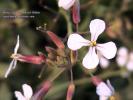 | |
| MaltaWildPlants.com by Stephen Mifsud |

|
| |
|
|
 |  |  |  |
| External Links: |
|
Narcissus deficiens (Triparted-crown late Narcissus) |
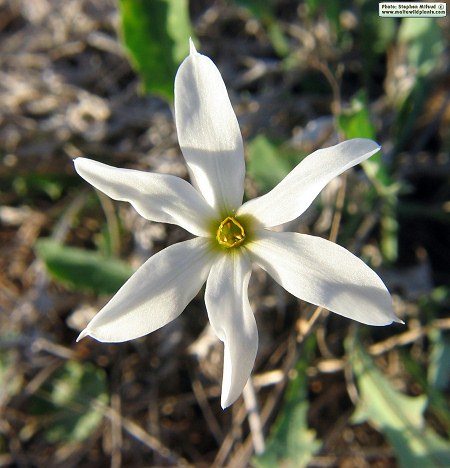
Narcissus deficiens (AMARYLLIDACEAE.)
Images for this profile are taken from the Maltese Islands after year 2000. |
|
| Nomenclature |
Species name : | Narcissus deficiens Herb. | Authority : | | Synonyms :
(basionym or principal syn.) |
|
Plant Family : | Amaryllidaceae Jaume St.-Hil
(Daffodil or Amaryllis Family) | English name(s) : | Triparted-crown late Narcissus, Triparted-crown autumn Narcissus, Herbert's autumn Narcissus | Maltese name(s) : | Narċis imwaħħar, Ranċis imwaħħar | Status for Malta : | Indigenous. Present on the Maltese islands before man | Name Derivation : |
Narcissus: To numb, stun or paralyze, referring to the narcotic properties of several plants in this genus. In Greek mythology Narcissus was an attractive youth who fell in love with his own image in water and pined away for it until he died and changed into the narcissus flower. (Greek origin ); 2 = To numb, stun or paralyze, referring to the narcotic properties of the plant. (Greek); In Greek mythology Narcissus was an attractive youth who fell in love with his own image in water and pined away for it until he died and changed into the narcissus flower. (from Funk and Wagnall).
deficiens: 1 = Late in developing. (Latin).
| Remarks : | |
|
| Morphology and structure |
PLANT STRUCTURE: |
Character | Growth Form | Branching | Surface |
Description | | | |
General
Picture |  | 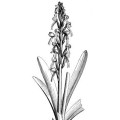 |  |
|
LEAVES: |
Character | Arrangement | Attachment | Venation |
Description | | | |
General
Picture | 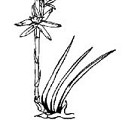 | 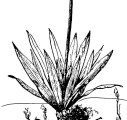 |  |
| |
Character | Leaf Shape | Leaf Margin | Remarks |
Description | | | After Flowering: Leaves grow after the flowering period and so they are not seen together with flowers. |
General
Picture | 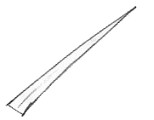 |  |  |
|
FLOWERS: |
Character | Colour | Basic Flower Type | No. of Petals | No. of Sepals |
Description | White (with yellow centre). | | 6 To be botanically precise, the flower has 3 sepals (outer whorl) and 3 petals (inner whorl) which are identical, and so they are collectively referred to as 6 tepals or perianth segments. | 0 |
General
Picture | | 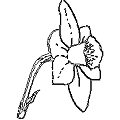 |  |  |
| |
Character | Inflorescence | Description | Ovary | Stamens |
Description | | The flowers have a fairly long green tube which opens into 6 radially symmetrical white petals. The centre has a small yellow circular crown formed by 6 tiny flaps and inside are visible the 3 upper yellow anthers. | | |
General
Picture |  |  | 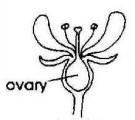 |  |
| |
Character | Scent | Average Flower Size | Pollen Colour | Other Notes |
Description | YES Sweet fragrant scent. | 20-28 mm
| Yellow | - |
|
SEEDS: |
Character | No. Per Fruit | Shape | Size | Colour |
Description | 24-36 | Irregular: More or less conical or tooth-like shape. | 2mm | Black |
General
Picture |  |  |  |  |
|
FRUIT AND OTHER BOTANICAL DATA: |
Character | Fruit Type | Colour of Fruit | Subterranean Parts | Other Notes |
Description | | Green Turns to straw colour when ripe. | | - |
General
Picture | 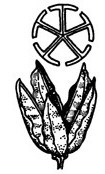 |  |  |  |
|
|
| Plant description and characters | |
Life Cycle: | |
Growth Form: | GEOPHYTE (bearing underground bulbs, rhizomes, stolons, etc.) |
Habitat: | Garigue, steppe, rocky wasteland. |
Frequency: | Common |
Localities in Malta: | |
Plant Height: | |
| Sep-Nov |
Protection in Malta: | Not legally protected till the last update of this website (2/Mar/2022) |
Red List 1989: | Not listed in the Red Data Book of the Maltese Islands |
Poison: | |
This perennial monocot appears in a very short period in Malta, where the flowers form during the month of October only and the leaves develop later after the flowering phase and remain for several weeks more. The plant is formed from a small black or dark brown bulb that is found few cm under ground level. The bulb measures 15-20mm across and has several thickened white roots. It forms one slender glabrous flowering stalk (average 10-15cm long) with a solitary terminal flower (rarely 2).Photo There is a sheath around the stalk where the flower is located.
The flower starts as a narrow green tube about 12-17mm long which opens up into an actinomorphic flat-faced flower consisting of 6 more or less identical, lance-shaped, pointed, white tepals. It can be noted that tepals are developed from 2 whorls of 3 each, where the lower whorl (= 'sepals') produces tepals thate are slightly more broad than the whorl above (= 'petals'). The centre of the flower contains a small (about 2mm across) yellow crown made up of 6 tiny flaps. The flaps of the crown are very shallow in comparison to other narcissus species which have a prominent large crown. Inside the crown there are visible 3 yellow anthers and sometimes the green stigma. The flower has a total of 6 stamens, of which 3 are upper at the crown region, and 3 are lower in the neck of the tube and hence not visible. There is a single style+stigma which runs down and meets the inferior ovary at the base of the flower tube.
The flower produces one fruit capsule which has an oval shape and is about 1cm long. When ripe, the capsule splits into 3 parts longitudinally and bears the small black seeds which have no obvious means of dispersion. The seeds are tooth-like in shape and are about 2mm in size.
After the flowering and fruiting phase, the leaves emerge from the bulb. These are very narrow (1-2mm) and long ensiform shaped leaves which remain more or less at ground level. Often the leaves are twisted. The bulb gives rise to few leaves and often they are not observed due to of the surrounding vegetation during late Autumn and early Winter.
|
|
| Information, uses and other details |
Nativity and Distribution
According to [WWW-66] , this plant is native to Africa and most of the Mediterranean coasts which include :
- Northern Africa: Algeria
- Western Asia: Cyprus; Israel; Lebanon; Syria; Turkey
- Southeastern Europe: Greece (incl. Crete); Italy (incl. Sardinia, Sicily); former Yugoslavia
- Southwestern Europe: France (incl. Corsica); Portugal; Spain (incl. Baleares}
Medicinal Uses
Not much medicinal information has been found about this Mediterranean Narcissus. However Duke's ARS website states that the plant has the following medicinal properties [WWW-66] :
| Sclerotic |
Acts against sclerosis that is any pathological condition which hardens or thickens tissue, with particular reference to the sclera of the eyeball [WWW-32] |
| Anti Tumor |
Used to control tumor growth and reduce its development [WWW-32] |
Additionally ARS website states that all Narcissus species have the following medicinal properties [WWW-66]
| Head-ache |
acts to relieve headache - a dull persistent (usually moderately intense) pain in the head [WWW-32] |
| Asthma |
A respiratory disorder characterized by wheezing; usually of allergic origin [WWW-32] |
| Anti-Flu (Cold) |
Acts against flu type of disease like the common cold [SM] |
| Anti-Diarrhoea |
Frequent and watery bowel movements; can be a symptom of infection or food poisoning or colitis [WWW-32] |
| Emetic |
a medicine that induces nausea and vomiting [WWW-32] |
| Against Epilepsy |
A disorder of the central nervous system characterized by loss of consciousness and convulsions [WWW-32] |
| Against Malaria |
An infective disease caused by sporozoan parasites that are transmitted through the bite of an infected Anopheles mosquito; marked by paroxysms of chills and fever [WWW-32] |
| Against Spasm |
A painful and involuntary muscular contraction [WWW-32] |
| Against Ulcer |
Sore on the skin surface or on the stomach lining. [WWW-32] |
| Treat Warts |
Treating warts which are described as firm abnormal elevated blemish on the skin; caused by a virus [WWW-32] |
| Against Whooping Cough |
An infectious disease characterized by catarrh of the respiratory tract and peculiar paroxysms of coughing, ending in a prolonged crowing or whooping respiration. It is caused by the bacterium Bordetella pertussis. [WWW-32] |
Personal Observations
The flaps forming the crown
Several reports and photos describe the flower that its central yellow crown consists of 3 flaps. This can be seen in the photographs found at the website www.bulbsociety.com (Click here to view photos). However the flowers of the species in Malta have 6 flaps (click here to see photo) It is difficult to establish why there is this difference, but there is a slight possibility that each species belongs to a different variety. There are at least 3 varieties of this species hence N. serotinus var serotinus, N.serotinus var deficiens, N.serotinus var emarginatus as indicated in this document which lists all the species names of the Narcissus Genus. It is good to state that this 6-flap crowned flower is not endemic to Malta, but it is found in other Mediterranean places (For example in Spain) [SM]
Life Cycle of the Plant
Around the end of September the small dark-brown bulb starts forming the aerial part of the plant. The first end-of-Summer rainfall and temperature drop triggers the bulb for growth. A single (or rarely two) leafless, flowering stalk is produced which normally holds a solitary terminal flower that opens up in early October. In rare cases, 2 or 3 flowers are produced. No leaves are produced at this stage. The flower has a green long tube about 15mm long. It is assumed that nutrients in the bulb aided by photosynthesis in the green stalk and flower tube is sufficient for growth and development of the flower and fruit. The flowers are short termed and they soon develop into a fruit capsule which ripens and produces seeds around the beginning of November. Flowering season of the plant is only for 3-4 weeks during the month of October. After fruiting, the stalk withers and soon after the leaves are produced. The plant produces few thread-like leaves lying on the ground, which often are covered by neighbouring vegetation. The leaves provide energy for the production of new underground bulbs. [SM]
Emanuel Caruana has submitted his own observation regarding the life cycle of this plant. He wrote that this flower appears shortly after the first heavy rain at the end of summer. (Usually October) It produces only one long, tubular leaf which comes out after the flower has withered. This flower is out of season in a very short time although the leaf remains for several months during the winter. Although it normally produces only one flower on the stem, it is sometimes found some with 2 flowers. In 2007 he found a clump of Narcissus serotinus with 5 or 6 flowers on each stem! Unfortunately Mr. Caruana had no camera with him and when went back a week later, they had all withered away.
Maltese name derivation
The name 'imwahhar' must not be confused with that of 'imhawwar' which means spicy or herbal. This plant has no edible use, more less as a spice or a herb. 'Imwahhar' simply means lately out of season, similar to the English and Latin meanings for this plant.
|
|
| Links & Further literature
(1 papers) |

Google Web |

Google Images |

Google Scholar |

Research Gate |

Wikipedia |

JSTOR |

GBIF |

Med Checklist |

Cat. of Life |

EoL |

IPNI |

World Flora Online |

Plants of the World Online |

Vienna Virt. Herb. |

RBGE Herbarium |

KEW Herbarium |

MNHN |

Arkive |

IUCN |

CABI |
 |
Records of Narcissus elegans (Fam. Amaryllidaceae) and notes on the wild narcissus in the Maltese Islands |
Stephen Mifsud and Emanuel Caruana (2010) |
Kindly Email if there are papers and publications about local
studies or information about this species to be included in the list above.
|
| Photo Gallery (28 Images) |  |
 |
 |
 |
IMAGE: NRCDF-01 Photo of the white, star-shaped flower with a small yellow centre. |
IMAGE: NRCDF-02 Photo of flower showing 3 anthers protruding partially from the centre. The flower has a total of 6 stamens of which 3 are hidden inside the flower throat (or neck) and not visible from the exterior. |
IMAGE: NRCDF-03 Species of Narcissus have flowers with a conspicuous central crown which is a ring or collar at the central part of the flower. As shown in this photo, the crown of Narcissus serotinus is shallow and small. |
IMAGE: NRCDF-04 Photo (lateral view) of flower showing the shallow crown. On contrast, Narcissus tazetta, another wild plant in Malta, have a pronounced crown. |
 |
 |
 |
 |
IMAGE: NRCDF-05 Photo of flower in situ showing that the central crown is made of tiny flaps. |
IMAGE: NRCDF-06 Photo of flower in situ. In this particular flower, the green stigma can be seen inside the crown. Often this is covered by the large anthers. |
IMAGE: NRCDF-07 Photo of a flower. Note the pointed tips of the petals and the yellow colour that diffuses slightly from the crown to the petals' base. |
IMAGE: NRCDF-08 Photo of an unusual occurrence of a plant with 3 flowers arising from a common flowering stalk (scape). Almost all plants produce one flower each, but 3 flowers from the same plant is extremely rare in Malta. |
 |
 |
 |
| IMAGE: NRCDF-09 Photo of another specimen against a dark background with its 6, pure white, free tepals. |
IMAGE: NRCDF-10 Photo of a typical flower, found blooming in Malta between October an November. |
IMAGE: NRCDF-11 Photo of a specimen with 2 flowers. About 1% of a population of N. serotinus have 2 flowers. |
IMAGE: NRCDF-12 - |
 |
 |
 |
 |
IMAGE: NRCDF-13 A rather rare sight of numerous specimens clumped close together forming a small tuft. Normally, N.serotinus is a solitary plant. The closely related species - N. elegans normally forms clumps, but this species have 3-6 flowers per scape, unlike the plants in this photos which almost all bear 1 flower (or bud). |
IMAGE: NRCDF-14 Another photo of same population from a different angle. |
IMAGE: NRCDF-15 Close up image reveals that there is one flower per scape (=per plant). |
IMAGE: NRCDF-16 Close up photo of the central part of a flower showing the yellowish structure called the crown. Sometimes this is greenish in colour and have very little taxonomic value. |
 |
 |
 |
 |
IMAGE: NRCDF-17 Scanned image of 2 typical flowers. They measure about 24mm and have a central crown of just 2mm across. |
IMAGE: NRCDF-18 Scanned image of flower against a dark background. Further observation reveals that the flower consists of 2 whorls of 3 petals each. The lower whorl have more broad petals with a more developed pointed tip in comparison with the petals of the upper whorl. Some consider the upper whorl as the true petals and the lower whorl as the sepals. |
IMAGE: NRCDF-19 Scanned image of flower (lateral view) showing the green tube that runs under the flower to meet the inferior ovary. The tube measures about 12-17mm in length. |
IMAGE: NRCDF-20 Scanned image of entire flower and stalk. The stalk is glabrous and forms a small sheath at the flowering locus. The stalk gives rise to one solitary terminal flower although 2 flowers have been reported to have been found in rare occasions. The length of the stalk varies from 5 to 20 cm. |
 |
 |
 |
 |
IMAGE: NRCDF-21 Scanned image of a longitudinally dissected flower. It contains a set of 3 stamens at the upper part of the flower (at the crown zone) and another set of 3 stamens inside the neck of the tube. The former have very short filaments, while the latter set have long filaments emerging from the base of the flower. The swollen inferior ovary lies at the base of the flower. |
IMAGE: NRCDF-22 Scanned image of longitudinally dissected flowers showing their anatomy. |
IMAGE: NRCDF-23 Photo of plant during the flowering period in October. It is not rare to encounter a plant with 2 flowers from the same scape. Leaves are formed after the flowering period, and they are filiform to linear (looking like a lace). |
IMAGE: NRCDF-24 Photo of the flowering stalk and flower. Note the membranous sheath formed at the base of the flower. |
 |
 |
 |
 |
IMAGE: NRCDF-25 Photo of the underground bulb. It is dark brown, measures about 18-20mm and produce few thick white roots when it is in flower. This bulb was about 4cm below soil level. |
IMAGE: NRCDF-26 Photo of fruit capsules in situ. They are dehiscent type of capsules which are ripe between November and January. |
IMAGE: NRCDF-27 Scanned image of a ripe capsule. It is divided into 3 longitudinal compartments in which the black seeds are compactly stored. The fruit splits open longitudinally along these compartments. |
IMAGE: NRCDF-28 Scanned image of the black seeds. They are tooth or irregular shaped and about 2mm in size. All these 29 seeds shown here were taken from a single capsule. |
 |
| | | IMAGE: NRCDF-29 |
IMAGE: NRCDF-30 |
IMAGE: NRCDF-31 |
IMAGE: NRCDF-32 |
|
| | |

